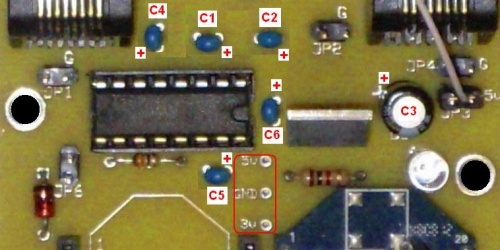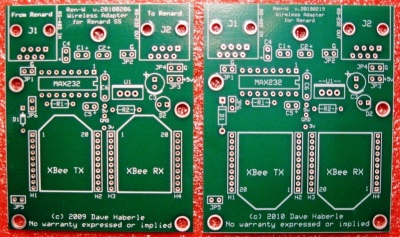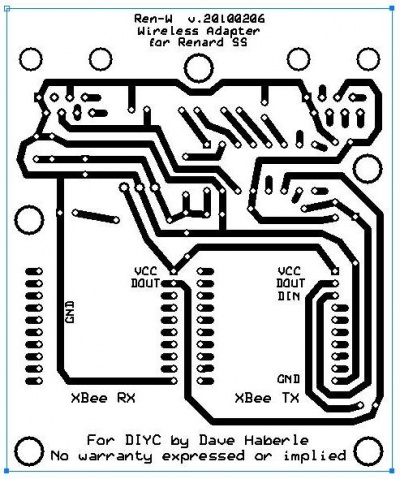Ren-W Troubleshooting
The Ren-W circuit board is a very simple design but good soldering technique is still extremely important.
Voltage Measurements: three test points are just below pin 16 of the MAX232 chip/socket (circled in red):
Construction Mistakes
- Be certain that the following components are mounted on the board properly:
- The notch on the MAX232 chip faces to the right, toward the U1 voltage regulator.
- The zener diode (D1) has the black stripe on the TOP, next to the JP6 header pins.
- The 3.3 voltage regulator (U1) has the metal tab facing up, toward the JP2 header pins.
- The electrolytic capacitor (C3) has the - stripe facing DOWN toward the LED, which means the + side is up toward the J2 jack.
- Capacitors C1, C2 and C3 are needed at the very least and you may find that your Ren-W works fine without optional capacitors C4, C5 and C6. However, these three additional capacitors do a lot to clean up the RS-232 serial signal output and adding C4, C5 and C6 are highly recommended if you encounter inconsistent communication from the Ren-W to your Renard controller.
- If using an electrolytic capacitor for C1, C2, C4, C5 or C6, be sure its polarity is correct. The + sides are marked on the board; the opposite side it obviously the - side, which is marked on the capacitor itself.
- The LED (D2) while not very clear in this photo, has the cathode (flat side) facing the mounting hole to its right.
- Resistor R1 (33 ohms) is immediately below the MAX232 chip. The resistor has no polarity concerns.
- Resistor R2 (1k ohms) is immediately below the U1 voltage regulator. The resistor has no polarity concerns.
- Be sure to observe the XBee module's orientation as printed on the board; remember that the standard board has the XBee pointing upward while the SMA board has the module pointing downward. If you have the standard board, DO NOT simply turn the module around to point downward for an XBee module with an SMA connector -- it will not work and you may damage the radio when power is applied!
Soldering Mistakes
- When you study the underside (copper) side of the circuit board, a few things become readily apparent:
- Very few pins of the XBee radio modules are actually used; most are unused and serve only to hold the header sockets securely.
- The solder pads for the XBee headers are very small; accurate and careful soldering is a must to prevent solder bridges. A solder bridge could easily prevent the XBee radio from functioning properly and could damage it. Note the elongated pads for the XBee headers, too. These provide home etch boards will a larger soldering surface.
- Note that the cat5 jacks J1 and J2 include additional solder pads for pins that don't connect to anything. These are provided for home etch boards by providing additional soldering area and strength in holding the jacks to the board.
Cabling Mistakes
- The Ren-W does not need a special cable when connecting J1 or J2 to the Renard controller. A standard cat5 cable with standard pinouts should work fine. It's a good idea to keep this relatively short inside a controller box so that you don't end up with a coil of wire, which could affect transmission. Otherwise, the length of the cat5 cables connecting the Ren-W to the controller should be limited to 50 feet or less, the recommended maximum for RS-232 communications.
- Important: When connecting a Ren-W directly to a computer's RS-485 output to be a "transmit only" unit, remember that the Ren-W takes input only on pin 5 of J1 connector and ground is made on pins 1-2. You may need to make a special cable by connecting RS485+ to pin 5 before plugging it into J1 of the Ren-W.
Other Easy Mistakes
- Plugging the XBee module into the wrong side of the board for the kind of function the board is to do. Remember:
- A receive-ONLY Ren-W has the XBee mounted in the RX (right) side and no jumper is on JP5. The cat5 cable is plugged into J2 and into the J2 socket of the Renard SS controller (the controller's RS-232 IN port)
- A transmit-ONLY Ren-W has the XBee mounted in the TX (left) side and no jumper is on JP5. The cat5 cable is plugged into J1 and into the J1 socket of the Renard SS controller (the controller's RS-485 OUT port).
- An E-Mode Repeater has is exactly the same as a transmit-only board but JP5 is jumpered instead. Cat5 cables connect both jacks J1 and J2 to the Renard controller's RS-485 OUT and RS-232 IN ports respectively.
- Connecting J1 to the Renard controller for a receive-only Ren-W won't work because a receive-only Ren-W uses J2 for the cat5.
- Connecting J2 to the Renard controller for a transmit-only Ren-W won't work because a transmit-only Ren-W uses J1 for the cat5.
- Misconfiguring the 16-bit address of an XBee module.
- Misconfiguring the LOW address of an XBee module.
- Setting the destination address of an XBee module to the wrong address. (This is a hard one to find!)
- Setting one radio to transmit to a specific destination XBee but not having the destination XBee in the test.
- Changing the PANID to the wrong value; remember, only radios with the same PANID can communcate with one another.
- Forgetting to set the Renard controller to accept RS-232 data.
- Mounting the Ren-W so the antenna is too close to a transformer or even a triac on the Renard controller can cause erratic transmission and/or reception behavior.
- If using the Ren-W to transmit control commands to a Ren-C/595 or Ren-C/Grinch controller, be sure that the cat5 cable that goes from J2 of the Ren-W to the Rs-IN jack of the Ren-C has a choke core balun affixed to it (Radio Shack part# 273-0069). You might also coil the cat5 cable into 4 or 5 loops approx 5" across if the balun alone doesn't solve the problem. This will reduce the amount of EMI/RFI that the XBee radio produces, which the ren-C may mistakenly see as serial input and cause framing errors. It's also possible that the framing error LED on a Ren-C may light even though everything is functioning properly. This is likely due to some of the XBee's EMI getting through anyway and is probably not a critical issue.
- Unplugging or plugging-in an XBee module while the Ren-W board is powered up. This can adversely affect and XBee module, and it's just good practice to remove power from it before unplugging anything.
- Resetting an XBee module back to its default specs (an option in the XCTU software) but forgetting to reset the baud rate back to 57600 before putting it back in a Ren-W socket.
Transmission Test
- This procedure gives you a chance to see what the Renard data looks like to a controller and it serves ad a terrific way to test a transmitting Ren-W board as well as a receiving XBee module to make sure they're using the same communication parameters.
- Set up a Ren-W in transmit only mode (XBee in the TX side, standard cat5 cable connecting from the RS-OUT jack of the Renard to the RS-IN jack of the Ren-W, Ren-W powered on.)
- Plug your computer's serial output into the Renard controller's serial IN. Either RS-232 or RS-485 is fine. Just connect it to your computer's serial port as you would normally.
- Use an USB XBee Explorer programmer board with an XBee radio plugged into it as the "receiver."
- Plug the Explorer board into the computer
- Start up the XCTU software, connect to the XBee radio.
- Open the TERMINAL window, select the SHOW HEX button.
- Leave the screen open so you can view it.
- Start up Vixen
- Define a new profile with twice as many channels as the Renard controller you're using. If it's an SS16, then create a 32-channel profile using the Renard Dimmer (modified) plugin.
- Open a new sequence and link it to the new profile you just created.
- Make Vixen's screen smaller so you can see both Vixen and the XCTU Terminal screen at the same time.
- Open Vixen's channel test feature. When it appears on the screen, your should see a block of HEX information pop into the XCTU screen's window. You'll see a 7E 80 sequence followed by as many pairs of zeros as half of your total channel count. If you have defined a 32 channel profile and are using an SS16, then you'll see sixteen pairs of zeros.
- On Vixen's channel test box, click the SELECT ALL button. You'll see the XCTU screen fill with another 7E 80 followed by pairs of FFs, representing "all on" for all the channels. Click the UNSELECT ALL button and the screen will return to zeros.
- Use the slider bar when the lights are "all on" and watch the XCTU screen fill with data. Each slider bar change sends a whole set of data for all channels. You'll be amazed how much data is processed, and how quickly, too.
- You can play an actual sequence in this way, too, and watch all the data flow through to what the transmitting Ren-W board thinks is another Ren-W, but is actually just an XBee radio. You'll be able to see patterns emerge after a while.
Additional Ren-W Links


